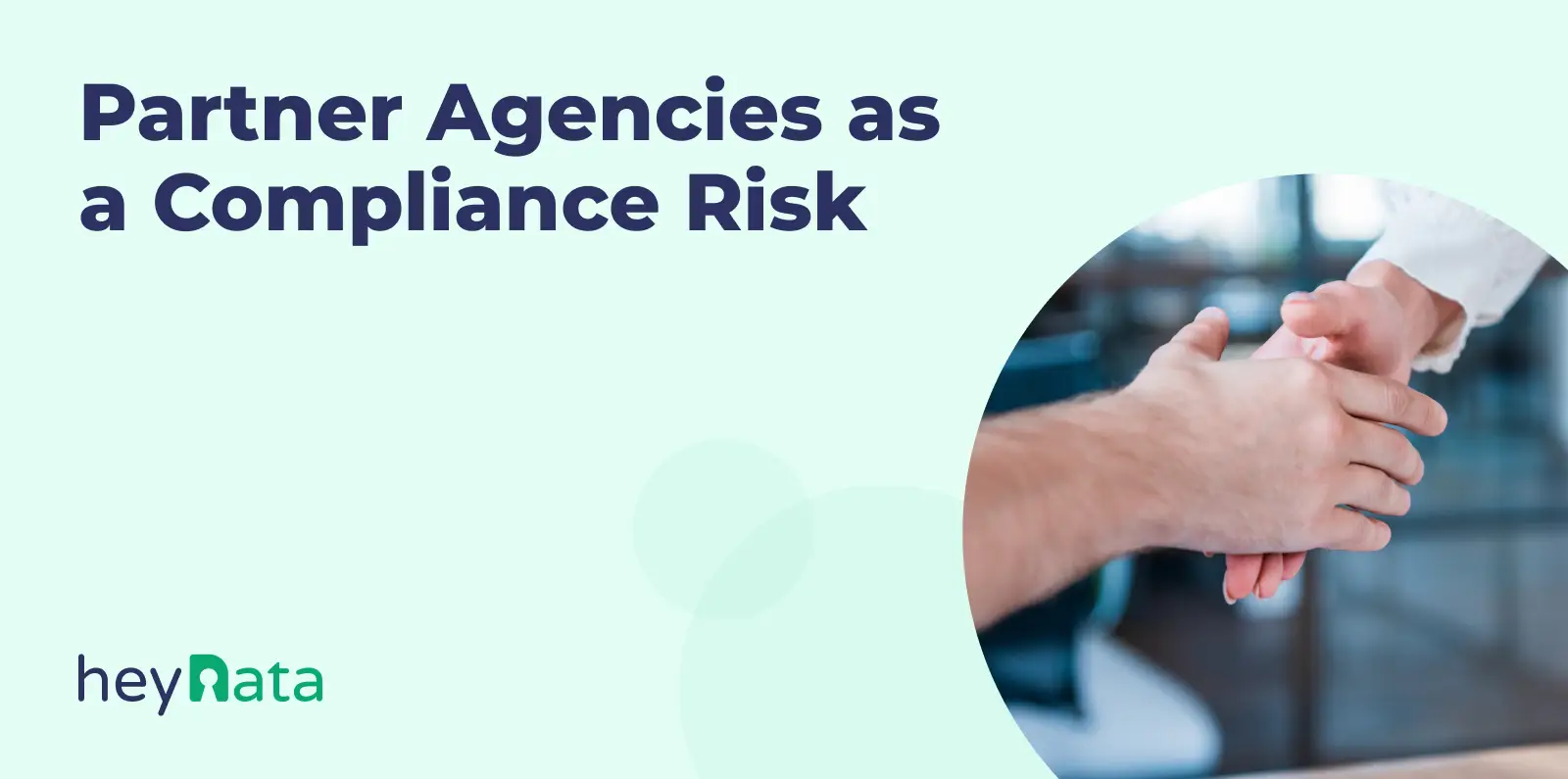
Partner Agencies as a Compliance Risk: Why Companies Must Monitor Their Service Providers More Closely

Working with agencies is essential for many companies, but it also introduces hidden compliance risks that are often underestimated. Without active oversight, businesses risk violating data protection laws or regulatory standards. The consequences? Costly fines and lasting reputational damage.
Table of Contents:
Introduction: Trust Is Good, But Control Is Essential
In today’s business environment, collaborating with partner agencies and external service providers is often necessary to remain competitive and efficient. But alongside the benefits these partnerships offer come significant risks, especially in terms of compliance.
Companies must ensure that their partner agencies are not only contractually obligated to comply but are also continuously monitored to verify adherence to legal and regulatory requirements. In the world of compliance, trust alone isn’t enough—control is essential.
The Role of Compliance in Working with Partner Agencies
Compliance goes beyond legal requirements, it’s a cornerstone of responsible corporate governance. A strong compliance culture doesn’t just protect against penalties or sanctions; it also builds trust among customers, partners, and investors.
This is particularly important when working with external agencies. Any violations of data protection, labor regulations, or sector-specific rules by third parties directly affect the contracting company—legally and reputationally.
It's not enough to rely on contract clauses. Companies must ensure that agencies not only commit to compliance on paper but also implement the necessary standards in practice, including:
- Data protection (e.g. under GDPR, Art. 28 ff., including data processing and transparency obligations)
- Information security (e.g. through ISO 27001 implementation)
- Industry-specific compliance (e.g. FinVermV in finance, Medical Device Regulation in healthcare, or sectoral requirements in energy)
Only companies that systematically extend and enforce these requirements to third-party providers can effectively manage compliance risks.
Common Compliance Risks Posed by External Service Providers
Working with agencies brings expertise and efficiency, but also potential vulnerabilities. If third-party partners don’t adhere to the same compliance standards, companies can face legal, financial, and security-related consequences.
Typical risks include:
- Inadequate data security
→ e.g. lack of encryption, insecure tools, outdated software - Missing or weak data processing agreements (DPAs)
→ e.g. unclear terms on data usage, lack of instruction binding - Opaque subcontractor structures
→ e.g. unknown data flows through third-party providers or foreign servers - Violations of labor or industry-specific regulations
→ e.g. failure to meet minimum standards in finance, healthcare, or education
A key risk lies in partners applying lower standards for privacy and security—potentially leading to data breaches, legal violations, and damage to the contracting company.
Example: A marketing agency uses a US-based tracking tool without a valid legal basis for international data transfers under GDPR Chapter V. The agency wasn't properly vetted, and a DPA is missing. Despite the error being on the agency's side, the hiring company is held accountable, risking fines and reputational harm.
Strategies for Effective Oversight of Partner Agencies
While compliance risks can’t be eliminated, they can be significantly reduced through structured processes and active monitoring. Companies should establish a system to manage and regularly audit the data protection and security practices of their partner agencies.
1. Thorough Due Diligence Before Contracting
Before hiring, agencies should be assessed against clear privacy and compliance standards, including:
- Self-assessments on GDPR compliance
- Proof of certifications (e.g., ISO 27001, TISAX)
- Evaluation of risk profile (types of data, depth of processing, international transfers)
2. Contractual Safeguards with Clear Requirements
A legally binding contract is a must, ideally including:
- A data processing agreement (DPA) under Art. 28 GDPR
- Specific terms on subprocessors and third-country data transfers
- Mandatory breach reporting and incident escalation clauses
- Sanctions for non-compliance with regulatory obligations
Tip: Clearly define responsibilities on both sides, including technical and organizational measures (TOMs).
3. Regular Audits and Self-Reporting
Even after a contract is signed, ongoing oversight is essential:
- Conduct internal or third-party audits for high-risk agencies
- Require annual self-assessments with supporting documentation
- Document all findings and follow-up measures thoroughly
4. Risk-Based Monitoring
Not all providers require the same level of scrutiny. Key factors to consider:
- What types of data are processed (e.g. health, location, financial data)?
- How critical is the agency to core business operations?
- Are there known past compliance issues?
This allows focused monitoring of high-risk service providers.
5. Documentation & Escalation Procedures
All audits, controls, and incidents must be clearly documented. In case of violations or irregularities, a well-defined escalation path should be in place, including assigned responsibilities, timelines, and consequences.
Tech Solutions for Scalable Compliance Management
Manual monitoring of dozens or hundreds of service providers is no longer feasible, especially for growing organizations. Technology plays a vital role in ensuring scalable, efficient, and auditable compliance oversight.
Modern compliance management systems (CMS) offer core features that help companies stay in control and respond proactively to risks:
Key CMS capabilities:
- Central directories of all vendors and DPAs
→ track processor status, documentation, and updates - Real-time incident and contract monitoring
→ alerts for critical changes or deadlines - Reminders for audits, contract renewals, or training
→ ensure nothing is missed and reviews stay on schedule - Built-in risk scoring
→ Prioritize oversight based on risk level
Digital Tools Make the Difference
These systems allow companies to detect and respond to violations early, before damage is done. They also improve coordination with external partners by clearly documenting processes, communication, and accountability.
Tip: Platforms like heyData offer an integrated solution tailored to these needs, including vendor management, DPA workflows, audit preparation, and automated compliance documentation.
Best Practices: Real-World Examples
Case 1: Mandatory Global Audit Program
A global software company introduced a compulsory audit scheme: all agencies working with customer data undergo regular privacy and security assessments. Results are documented in a central compliance dashboard.
Result: Serious incidents dropped by over 40%, and response times improved significantly.
Case 2: Mandatory External Training
A major e-commerce firm requires all external partners—from marketing to HR consultancies—to complete annual training on data protection, IT security, and relevant regulations.
Result: Compliance awareness rose significantly among partners. Fewer misunderstandings, better audit results.
Conclusion: Successful Partnerships Require Clear Rules
Working with partner agencies brings many benefits, but also significant compliance risks. To ensure secure and sustainable collaboration, companies must define clear rules and enforce them consistently.
By implementing structured monitoring strategies and leveraging the right technologies, organizations can reduce their compliance risks and build stronger, more accountable relationships with their external partners.
Important: The content of this article is for informational purposes only and does not constitute legal advice. The information provided here is no substitute for personalized legal advice from a data protection officer or an attorney. We do not guarantee that the information provided is up to date, complete, or accurate. Any actions taken on the basis of the information contained in this article are at your own risk. We recommend that you always consult a data protection officer or an attorney with any legal questions or problems.


